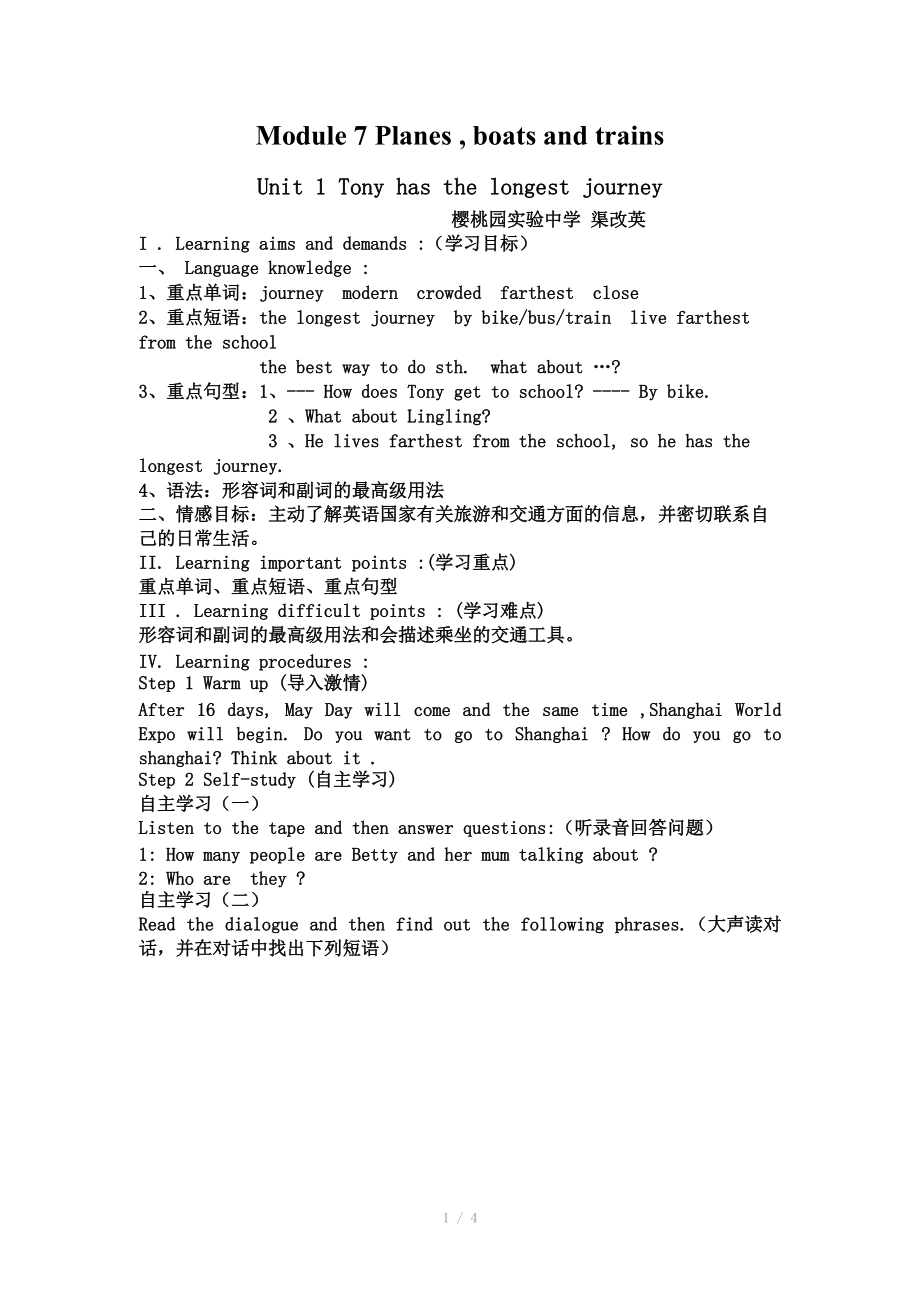《英語七年級下外研版Module 7 Planes , boats and trains Unit 1 Tony has the longest journey》由會員分享�����,可在線閱讀�����,更多相關(guān)《英語七年級下外研版Module 7 Planes , boats and trains Unit 1 Tony has the longest journey(4頁珍藏版)》請在裝配圖網(wǎng)上搜索�。
1、
Module 7 Planes , boats and trains
Unit 1 Tony has the longest journey
櫻桃園實驗中學(xué) 渠改英
I . Learning aims and demands :(學(xué)習(xí)目標(biāo))
一����、 Language knowledge :
1、重點單詞:journey modern crowded farthest close
2����、重點短語:the longest journey by bike/bus/train live farthest from the s
2、chool
the best way to do sth. what about …?
3���、重點句型:1���、--- How does Tony get to school? ---- By bike.
2 、What about Lingling?
3 ��、He lives farthest from the school, so he has the longest journey.
4�、語法:形容詞和副詞的最高級用法
二、情感目標(biāo):主動了解英語國家有關(guān)旅游和交通方面的信息�����,并密切聯(lián)系自己的日常生活。
3�、
II. Learning important points :(學(xué)習(xí)重點)
重點單詞、重點短語�、重點句型
III . Learning difficult points : (學(xué)習(xí)難點)
形容詞和副詞的最高級用法和會描述乘坐的交通工具。
IV. Learning procedures :
Step 1 Warm up (導(dǎo)入激情)
After 16 days, May Day will come and the same time ,Shanghai World Expo will begin. Do you want to go to Shanghai ? How do yo
4��、u go to shanghai? Think about it .
Step 2 Self-study (自主學(xué)習(xí))
自主學(xué)習(xí)(一)
Listen to the tape and then answer questions:(聽錄音回答問題)
1: How many people are Betty and her mum talking about ?
2: Who are they ?
自主學(xué)習(xí)(二)
Read the dialogue and then find out the following phrases.(大聲讀對話����,并在對話中找出下列短語)
1 /
5、4
1�����、住的最遠(yuǎn) _______________ 2���、最長的路程_________________ 3�����、最好的方式______________4�����、最快的路程_________________ 5���、最危險的方式____________6�、最舒服的方式_______________
自主學(xué)習(xí)(三)
Read the dialogue with your partner and then fill in blanks:(和你的搭檔一起分角色讀對話�����,然后填空)
Say who in Activity 5 .
Eg :Who lives farthest from the school?
6�、 Tony lives farthest from school.
1______________lives closest to school.
2______________ has the most dangerous journey.
3______________has the longest journey.
4______________has the most expensive journey.
5______________has the fastest journey.
6______________has the most uncomfortab
7�、le journey.
在以上句子中出現(xiàn)了closest ,longest , most expensive ,fastest ,most uncomfortable 等詞,你知道他們是什么形式嗎����?閱讀課本p149
當(dāng)我們需要對三個或三個以上的人或事物進(jìn)行比較,來表達(dá)最高���、最遠(yuǎn)��、最快等意義的時候��,我們可以用形容詞和副詞的最高級形式來表達(dá)���。
構(gòu)成方法:
一、單音節(jié)和少數(shù)雙音節(jié)
1_______________________________________________________
2_______________________________________________
8����、________
3_______________________________________________________
4_______________________________________________________
二����、多音節(jié)詞和部分雙音節(jié)詞
在詞前加most
注意:形容詞的最高級前一般要加定冠詞the, 而副詞的最高級前則可加也可不加the
練一練:寫出下列形容詞的最高級
1. long___________ 2. close ____________ 3. big ___________
4.busy__________5.dang
9�、erous_____________6.good___________
Step 3 Group work 合作學(xué)習(xí),共同提高
驗證自主學(xué)習(xí)的效果����,討論解決自主學(xué)習(xí)中遇到的問題。討論解決學(xué)生沒有提出���,經(jīng)過教師提出的問題�。
Step 4 Presentation 展示點撥
讓學(xué)生展示討論的成果��,教師予以總結(jié)���、提煉�����、升華�。
Step 5 Summary 課堂小結(jié)
讓學(xué)生談?wù)劚竟?jié)課的收獲�����。
Step 6 Have a check 達(dá)標(biāo)測試 (很容易喲)
一、用所給單詞的適當(dāng)形式填空
1 .Tony lives ___________ ( far) from the sch
10��、ool in his class.
2. Betty’s dad has _____________(expensive)journey .
3. Daming has ___________(dangerous) journey .
4. Lingling’s home is ________( close) to school.
5 .Daming has _________(fast) journey by bicycle.
二��、 根據(jù)所給漢語完成句子:
1 他住得離學(xué)校最遠(yuǎn)����。
He lives _______ _______ the school.
2 公共汽車
11�、是去上學(xué)最好的方法。
The bus is _______ _______ ________ to get to school.
3 它是世界上最快的火車�����。
It’s ______ _________ train in the world.
4 Mike 有時候乘船回家��。
_________ Mike ______ home ______ ferry.
Step 7 拓展運用 let’s listen to a song and then sing it after Link .
I won’t go to Shanghai by plane,
12�、‘Cos it’s the most expensive way.
I won’t go to Shanghai by ferry,
‘Cos it’s the most dangerous way.
I will go to Shanghai by bus,
‘Cos it’s the most popular way.
I will go to Shanghai by the fastest train,
‘Cos it’s the most comfortable way.
希望對大家有所幫助,多謝您的瀏覽����!
 英語七年級下外研版Module 7 Planes , boats and trains Unit 1 Tony has the longest journey
英語七年級下外研版Module 7 Planes , boats and trains Unit 1 Tony has the longest journey

